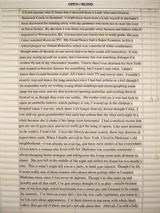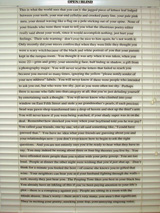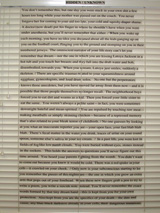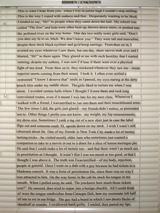Denise Duhamel & Julie Marie Wade
HUSH
Perhaps I never loved my mother enough to tell her anything true.
“What did you do at school today?” Nothing.
“Where did you go after school today?” Nowhere.
“Do you like your teacher more than me?” No, of course not.
While other girls were weaving daisy chains and rose bouquets, I stood in a different garden. Perhaps I loved her so much I could only pluck omissions, lies disguised as fragrant, purple garlands.
Who’s to say the sweetest-smelling flower is not also the most mendacious one?
* * *
Last night I took out a dress I bought in 1998 and still haven’t worn in public. Because it is covered in loose sparkles, I’ve been too afraid to leave a trail in a restaurant or at a friend’s. I tried it on, walked down the hall back and forth, then vacuumed all those golden twinkles. I think there is a metaphor in here somewhere—the dress representing the splash I’ve always wanted to make. I put the repressed dress back in its garment bag.
* * *
What about all the things people won’t tell us? I remember, when I finally was able to go through with my divorce, people said:
What took you so long?
I never could stand him.
Honestly, we all thought he was nuts.
I felt a tinge of paranoia, then understood that I would have made the same omission if I thought a friend was married to the wrong person.
I used to buy daisies every Friday at Publix to cheer myself up, but I haven’t needed to do that since my divorce.
* * *
The dress continues to dangle in its stark gray chrysalis near the closet wall. I have several like it. My mother made me wear dresses all my youth. When I came of age, I wanted only pants. Was it mere rebellion, hard-won freedom, a symbol of my new-found lesbian life?
No more “Friday Flip-Up Day” on the playground. No more girls—it was always the girls—making snide remarks about stubble and nicks and those wispy gold hairs growing back.
Yesterday I found two neckties in my underwear drawer, one silver, one bronze, both of them still unworn.
* * *
What about all the things we won’t tell ourselves? Once, riding a city bus, I glimpsed a poem by Kate Loeb: Some secrets I keep even from myself.
I was nineteen, maybe twenty. I had a long history of pretending. I wasn’t quite sure where make-believe ended and real life began. Soon, the poem became another secret I kept from myself.
Later, at a street fair, a fortune-teller told me I’d marry a good man, give him three children. I must have looked stricken, so she clutched my hand: Isn’t that a good thing? Shouldn’t you be glad?
* * *
I actually had a chance to wear a bowtie and tuxedo once as a groom’s person for Gregg and Rick’s wedding. I was amazed to learn how many figure “flaws” a man’s jacket can cover. I remember feeling inconspicuous. I had no urge to suck in my gut when pictures were snapped. And what about our out-of-shape president, those unflattering pictures of him golfing? When he wears a suit and that ridiculously long tie, he looks like a man of normal size.
* * *
Think of fake news. Yesterday I saw on Twitter: Believe it or not, this is a shark on the freeway in Houston, Texas. I did believe it! I was scrolling through the horrors of Hurricane Harvey. But it was soon proven a lie—the water on the highway real, but the shark had been photo-shopped.
* * *
How do we reckon with notions of normality? Do we always mean beauty when we say health, skinny when we mean fit? Is it “fat-shaming” if a man who brags about extra ice cream scoops makes weight requirements for his wives, dress requirements for his female staff?
In my shoe-selling days, a young woman sobbed when the tall boots she had purchased wouldn’t zip over the flesh of her calves. I tried to console her, but I was two-faced, pleased with myself. I owned the same pair, and they slid effortlessly all the way up to my knees.
* * *
What about fake news before we invented the phrase? In 1948, the Chicago Daily Tribune made its famous faux pas, DEWEY DEFEATS TRUMAN! The editors were embarrassed. They apologized for the mistake. A triumphant Truman held the newspaper over his head and reveled in their error.
As a child, I stood in checkout lines with my mother, pointed at all the tabloids: Satan’s skull found in New Mexico, Dolphin grows human arms, Elvis was an alien. She said, “Everybody knows they’re lies.”
Now some people read the New York Times and dismiss it as a leftist National Inquirer.
* * *
I once had a pair of wide-calf boots in high school and was so afraid someone would find out.
I remember to this day that a “medium” calf was up to 14 inches, and the yellow tape measure around mine read 15 inches. I remember exercising, sure if I did, my calves would slim down. But guess what? Though I lost weight, my calves grew to 15 and ½!
I remember reading a sentence in some horrible novel—John Updike maybe?—that said the calves were the last thing to go on a woman.
* * *
Last night I saw Fox’s Tucker Carlson tell a Black Lives Matter supporter that she was racist. I swear I am not lying—I was flicking through the channels on my way to Rachel Maddow. I looked at the “fair and balanced” train wreck, incredulous.
“All lives matter,” Tucker said stupidly as the black woman stayed calm.
I’m afraid to tell myself that America is on its way out. Maybe I’m lying when I say things have to get worse before they get better. What if they just get worse? And then it’s the end?
* * *
Remember when Juliet, dizzy with love and rationalization, said “that which we call a rose by any other name would smell as sweet”? But would that which is not a rose, if called a rose, turns tender in our mouths, bearable in our hearts? Could we outlast it?
I try renaming the world: President Rose, full of thorns. Shrouded rose on the hanger. Many roses of Texas, rising roses of Houston. Rose Times. Truth and roses. Rose and balanced. Is this merely looking the other way? Now everything is coming up—Roses we are, and to roses we shall return.
—from Rattle #59, Spring 2018
__________
Denise Duhamel & Julie Marie Wade: “We have been ‘rattled’ ever since the presidential election. This prose poem grew out of the general malaise of the country in addition to the news of Hurricane Harvey.” (web)






